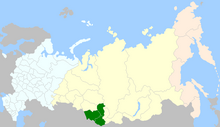Къуманды, Къуванды(г) Kumandy, Kuvandy(g) | |
|---|---|
 Distribution of Kumandins in the Siberian Federal District | |
| Total population | |
| 2,892 | |
| Regions with significant populations | |
| 2,892[1][2] |
| Languages | |
| Northern Altai (Kumandin dialect) | |
| Religion | |
| Orthodox Christianity,[2] also Shamanism, Burkhanism | |
| Related ethnic groups | |
| Altaians, Siberian Tatars, Khakas, Shors, Teleuts, Tofalar | |

The Kumandins (natively, Kumandy, Kuvandy(g)) are a Turkic Indigenous people of Siberia. They reside mainly in the Altai Krai and Altai Republic of the Russian Federation.[2] They speak the Northern Altai Kumandin language.[3][4]
According to the 1926 census, 6,335 Kumandins lived within the territory of Russia. In the 2010 census, the number was only 2,892, but possibly the 1926 census included some related peoples. Some Kumandins, living on the banks of the Biya River, from the Kuu River downstream, almost to the city of Biysk, and along the lower course of the Katun River, by 1969 were conflated with the Russians population.[5]
In the Soviet years and until 2000, the authorities considered the Kumandins to be part of the Altai people. Currently, according to the Resolution of the Government of the Russian Federation No. 255 dated March 24, 2000, as well as the Russian Census (2002), they are recognized as a separate ethnic group within indigenous small-numbered peoples of the North, Siberia and the Far East.[3] For ethnic rights protection was established the "Association of the Kumandin People Revival".[4]
- ^ Russian Census 2010: Population by ethnicity Archived 2012-04-24 at the Wayback Machine (in Russian)
- ^ a b c Nazarov, I.I.; Funk, D.A.; Kondratieva, N.M. (2020). "Кумандинцы" [Kumandins]. Большая российская энциклопедия/Great Russian Encyclopedia Online (in Russian). Archived from the original on 2019-04-02. Retrieved 2021-07-18.
- ^ a b "Kumandin". ELP Endangered Languages Project. Retrieved 2021-07-15.
- ^ a b Bitkeeva, A.N. "The Kumandin Language". Endangered Languages of Indigenous Peoples of Siberia. UNESCO. Retrieved 2021-07-15.
- ^ Potapov, Leonid P. (1969). Этнический состав и происхождение алтайцев. Историко-этнографический очерк [Ethnic composition and origin of Altaians. Historical ethnographical essay] (in Russian). Leningrad: Nauka. p. 21.